We are always looking at ways to upgrade and improve the quality of work here, whether that be through courses or equipment. So last month we invested in a new purchase with a 27hp Bandit stump grinder to join our fleet. This works now in addition to our smaller unit the stump humper, which is 20hp.
This new machine allows us to remove larger stumps, as it will fit through a 900mm gate. The stump humper can only fit through 760mm gates.
We recently gave it a good test run at a job where we ground a 1.2m diameter stump with ease, which cut down time and cost to our client. It proved it will be a great asset to our business.
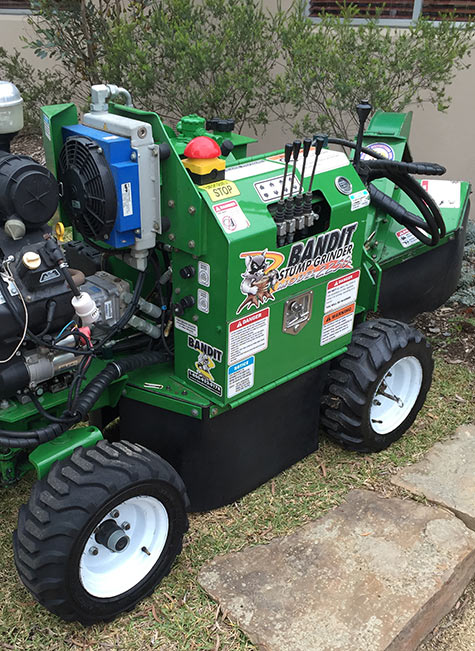
The Stump Humper
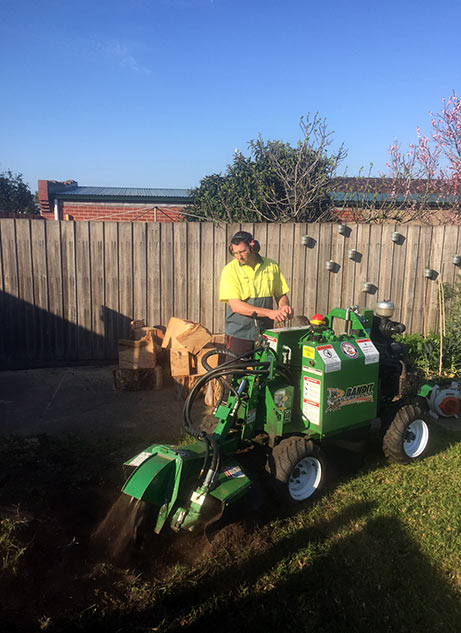
1.2m stump
Tree stump removal is important service that we offer, because leaving it in the ground can encourage wood decay, rotting, fungi and potential soil pathogens. There is also the possibility of attracting other pests that may carry diseases.
Unsightly stumps can also be hazardous for you and your family resulting in injury if it’s obstructing access into your garden. They also take up unnecessary space that can easily be resolved with our stump removal process. The stumps can then be converted into mulch, which you can leave to break down or spread around your garden.
We take absolute pride and careful consideration during the stump removal process so that your garden is left undamaged and your property left clean and tidy on completion of the job.
We are looking forward to using this machine on more future jobs; maybe the next one might be yours?
Because trees matter!
Until next month
The Assured Tree Care Team
Do you have a lemon tree in your back yard? Do you know someone who does? It is possible you grew up with one of these iconic backyard fruitful beauties, or maybe you had one of the other many varieties of citrus trees. With an abundant amount of tasty and nutritious fruit it is easy to see why they are a favourite amongst garden and cooking enthusiasts.
Unfortunately though, our beloved lemon and other varieties of citrus trees such as the grapefruit, have over recent years come under attack from a nasty pest. Meet the Citrus Gall Wasp an Australia native insect pest that is causing destruction to one of our favourite trees.
Originally a problem of citrus trees, in particular the native lime fingers, in Queensland and mid to north New South Wales, the Citrus Gall Wasp has over the last 20 years increased. It has now established itself around the regions of New South Wales, South Australia and Victoria where orange production is present. It has also spread around Melbourne making it a huge problem for local backyard gardeners.
The Citrus Gall Wasp are rarely seen as they are less than 3mm in size. The only way to know if your tree is harbouring these pests is if your tree has unsightly galls appearing. A severely infested tree can have over a hundred galls harbouring many wasps.
The infestation starts in early spring when the adult wasps mate and the female implants her eggs laying up to 100, usually under the bark of new shoots in the citrus tree. The larvae hatch after 2-4 weeks and the galls on the stems form as the larvae burrow into the twigs to feed and pupate over winter. The tree reacts by swelling and forming a gall giving the eggs room to grow. They then grow within the stem for 9-12 months until they become adults. Small holes in the galls indicate the wasp has emerged, but if there are no holes the pupating wasp is still in there. The emergence of the adult is influenced by temperature and the appearance of spring growth, but it cannot move far and really only travels with the prevailing winds living up to 3 -14 days.
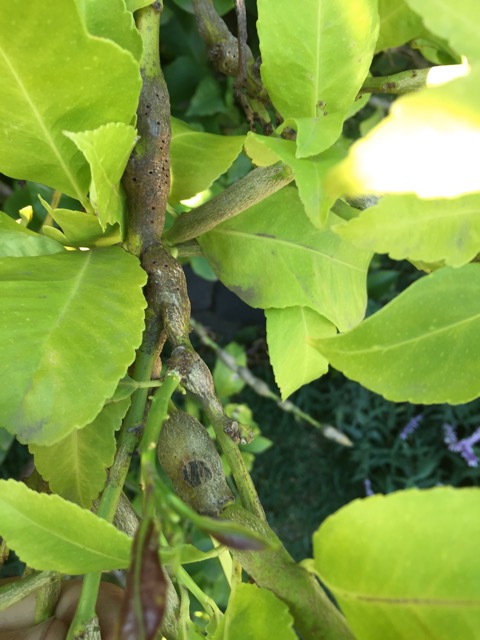
Examples of swelling on stem
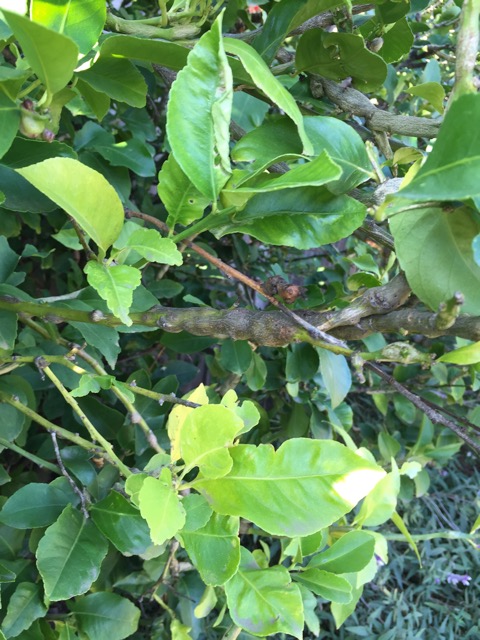
Lemon tree with exit holes on the galls
Part of the wider spread of this pest comes from the effects of climate change, which means the life cycle can be repeated during the year instead of just during the spring. It also comes from the distribution of infected trees into nurseries where trees have not been inspected.
The Citrus Gall Wasp is more damaging to younger tress rather than older ones. Heavily galled trees will result in no fruit, reduced fruit size or branch dieback. When the wasps emerge it slowly kills the tree. The damage cannot be cured or reversed, however it can be minimised by removing the galls. By removing newly form galls without the exit holes it will stop the spread of the adults. This should be done as they appear generally before August. Galls should be disposed of immediately (double sealed bag and binned) to prevent adults hatching and reinfecting the tree. For heavily infected trees, we recommend the installation of pest traps from August to November.
Keeping your tree well nourished, free of weeds and keeping the soil around the tree most with water and mulch can help combat these pests. Feeding them in autumn or early winter will also help keep the tree healthy.
We love our citrus trees. They offer so much to our backyard gardens and have been so much apart of our heritage. Caring for them as we would care for any other living thing helps give them the best chance to survive and be fruitful. So go out and check your beloved citrus tree and make sure there are no nasty pests harbouring in there!
Because trees matter!
Until next month
The Assured Tree Care Team
Elms have been an important part of the Melbourne landscape since their introduction in the 19th century as one of the first trees to be planted in our city. We often take for granted the beauty of these trees. A stroll along any of the avenues of honour of mature Elms we have, will remind us of their heritage and that they are some of the most significant in the world.
It is estimated that there are approximately 70,000 Elms in Victoria alone. Some have lived past 150 years of age, with the potential to live another 100 years. Two of the oldest English Elms are at the The Royal Botanical Garden named ‘Arthur’s Elms’. They were planted by the first Curator John Arthur in 1846.
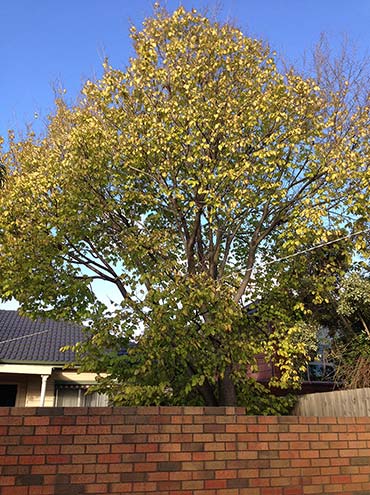
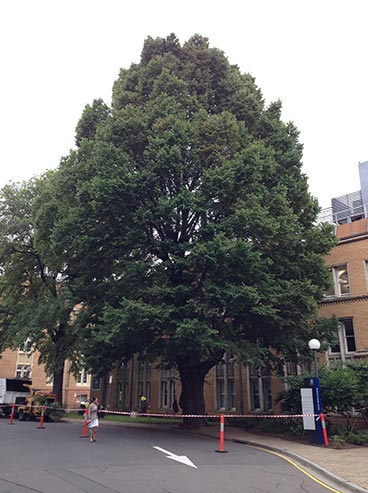
Examples of Elms we manage
Unfortunately other parts of the world have not been so lucky with their Elms. Dutch Elm Disease (DED) has killed millions of trees, beginning in France in 1918, then Holland, England, Europe, North America and more recently New Zealand. DED is a fungus which produces a toxin that blocks the tree’s vascular system. It is the elm bark beetle that spreads the fungus spores onto the tree and into the soil. The branches wilt, and leaves become yellow and eventually the roots die, starved of nutrients.
For now the threat of DED is not eminent and luckily this disease has not yet been found in Australia. The main concern for our Elms is the Elm Leaf Beetle (ELB). The Elm Leaf Beetle was discovered in a Bayside area not far from Melbourne around 1989 and is becoming increasingly more widespread. It has the potential to cause severe defoliation during the summer months which can weaken mature trees and possibly kill the tree. Elms that suffer from repeat attack are also more susceptible to other pests and disease.
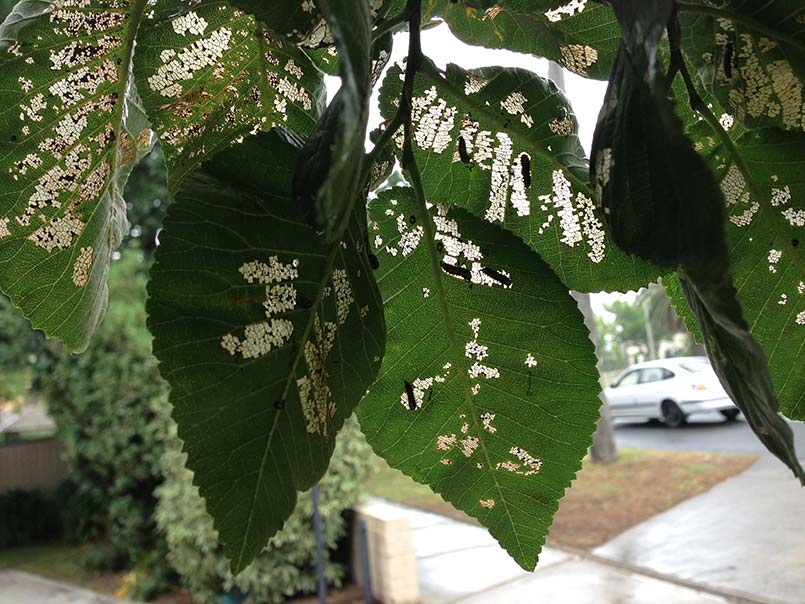
Elm Leaf Beetle Damage
To control the spread of Elm Leaf Beetle to the Elms we need to look at the cycle in which they grow. Over the winter months the beetles hibernate emerging in the spring where they begin to eat small holes in the leaves. By November the beetle lays tiny eggs which hatch after 7 -10 days producing small larvae. The larvae feed on the leaves leaving only the veins of the leaf behind. By December they have grown up to 12mm and begin to make their way down the trunk where they turn into pupae. 1-2 weeks later new beetles emerge and the cycle continues. This life cycle can happen 2-3 times a year depending on weather conditions causing great stress to our Elms.
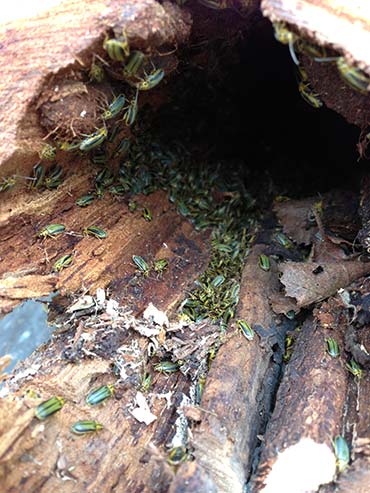
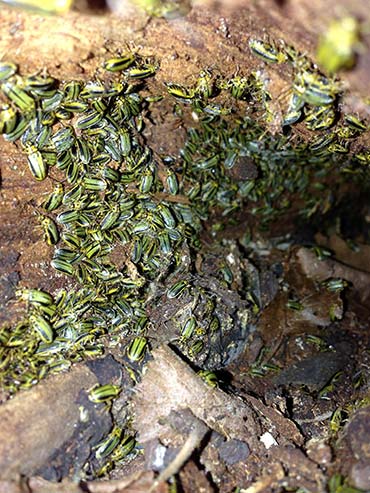
Elm Leaf Beetle over winter in a tree hollow
The best way to care for an Elm is to put a management plan in place. This includes treatment during the months of September and October every 2 years. Here at Assured Tree Care we have extensive experience, and equipment to undertake modern plant health treatments. We can provide soil and stem injections which through the careful use of systemic insecticides, control Elm Leaf Beetle numbers from spreading and in-turn improve the health of your tree.
Our motto is to ‘Promote longevity among trees’. We love the role they play in our environment and now more than ever they are an important part of the urban landscape. As more and more developments go up, more pressure is placed on existing trees and the available space in which they grow. This along with the threat of pests like the Elm Leaf Beetle makes it hard for our trees and in particular our friend the Elm. Therefore taking care of our trees and giving them the best chance is what matters, we need them just as much as they need us!
Because trees matter!
Until next month
The Assured Tree Care Team